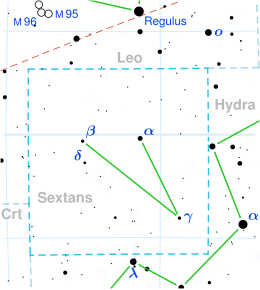19 Sextantis
 From Wikipedia the free encyclopedia
From Wikipedia the free encyclopedia
| Observation data Epoch J2000.0 Equinox J2000.0 (ICRS) | |
|---|---|
| Constellation | Sextans |
| Right ascension | 10h 12m 48.36462s[1] |
| Declination | +04° 36′ 52.8378″[1] |
| Apparent magnitude (V) | 5.78±0.01[2] |
| Characteristics | |
| Evolutionary stage | red giant branch[3] |
| Spectral type | K1 III[4] or K0 III[5] |
| U−B color index | +1.11[6] |
| B−V color index | +1.18[6] |
| Astrometry | |
| Radial velocity (Rv) | 31.80±0.21[7] km/s |
| Proper motion (μ) | RA: −50.538 mas/yr[1] Dec.: −6.118 mas/yr[1] |
| Parallax (π) | 6.3184 ± 0.0625 mas[1] |
| Distance | 516 ± 5 ly (158 ± 2 pc) |
| Details | |
| Mass | 0.88+0.08 −0.03[3] M☉ |
| Radius | 23.13±1.17[8] R☉ |
| Luminosity | 241+4 −5[1] L☉ |
| Temperature | 4,576±123[9] K |
| Metallicity [Fe/H] | −0.53[10] dex |
| Rotational velocity (v sin i) | 2.5±0.8[4] km/s |
| Age | 7.94+1.83 −0.70[3] Gyr |
| Other designations | |
| Database references | |
| SIMBAD | data |
19 Sextantis (HD 88547; HR 4004; 34 G. Sextantis), or simply 19 Sex, is a solitary star[13] located in the equatorial constellation Sextans. It is faintly visible to the naked eye as an orange-hued point of light with an apparent magnitude of 5.78.[2] Gaia DR3 parallax measurements imply a distance of 516 light-years[1] and it is currently receding with a heliocentric radial velocity of 31.8 km/s.[7] At its current distance, 19 Sex's brightness is diminished by an interstellar extinction of 0.17 magnitudes.[14]
19 Sex has a stellar classification of K1 III,[4] indicating that it is an evolved K-type giant star that has ceased hydrogen fusion at it core and it has left the main sequence. It has also been given a slightly hotter class of K0 III.[5] Stellar evolution models from Stock et al. (2018) model it to be a red giant branch star (100% chance)[3] that is currently fusing a hydrogen shell around an inert helium core. It has 88% the mass of the Sun but at the age of 7.94 billion years,[3] it has expanded to 23.13 times the radius of the Sun.[8] It radiates 241 times the luminosity of the Sun[1] from its photosphere at an effective temperature of 4,576 K.[9] 19 Sex is metal deficient with an iron abundance of [Fe/H] = −0.53 or 29.5% of the Sun's[10] and it spins modestly with a projected rotational velocity of 2.5 km/s.[4]
References[edit]
- ^ a b c d e f g Vallenari, A.; et al. (Gaia collaboration) (2023). "Gaia Data Release 3. Summary of the content and survey properties". Astronomy and Astrophysics. 674: A1. arXiv:2208.00211. Bibcode:2023A&A...674A...1G. doi:10.1051/0004-6361/202243940. S2CID 244398875. Gaia DR3 record for this source at VizieR.
- ^ a b Høg, E.; Fabricius, C.; Makarov, V. V.; Urban, S.; Corbin, T.; Wycoff, G.; Bastian, U.; Schwekendiek, P.; Wicenec, A. (March 2000). "The Tycho-2 catalogue of the 2.5 million brightest stars". Astronomy and Astrophysics. 355: L27–L30. Bibcode:2000A&A...355L..27H. ISSN 0004-6361. S2CID 17128864.
- ^ a b c d e Stock, Stephan; Reffert, Sabine; Quirrenbach, Andreas (August 2018). "Precise radial velocities of giant stars: X. Bayesian stellar parameters and evolutionary stages for 372 giant stars from the Lick planet search". Astronomy & Astrophysics. 616: A33. arXiv:1805.04094. Bibcode:2018A&A...616A..33S. doi:10.1051/0004-6361/201833111. ISSN 0004-6361. S2CID 247657118.
- ^ a b c d Henry, Gregory W.; Fekel, Francis C.; Henry, Stephen M.; Hall, Douglas S. (September 2000). "Photometric Variability in a Sample of 187 G and K Giants". The Astrophysical Journal Supplement Series. 130 (1): 201–225. Bibcode:2000ApJS..130..201H. doi:10.1086/317346. ISSN 0067-0049.
- ^ a b Adams, Walter S.; Joy, Alfred H.; Humason, Milton L.; Brayton, Ada Margaret (April 1935). "The Spectroscopic Absolute Magnitudes and Parallaxes of 4179 Stars". The Astrophysical Journal. 81: 187. Bibcode:1935ApJ....81..187A. doi:10.1086/143628. eISSN 1538-4357. ISSN 0004-637X. S2CID 121056016.
- ^ a b Johnson, H. L.; Mitchell, R. I.; Iriarte, B.; Wisniewski, W. Z. (1966). "UBVRIJKL Photometry of the Bright Stars". Communications of the Lunar and Planetary Laboratory. 4: 99–110. Bibcode:1966CoLPL...4...99J.
- ^ a b Famaey, B.; Jorissen, A.; Luri, X.; Mayor, M.; Udry, S.; Dejonghe, H.; Turon, C. (January 2005). "Local kinematics of K and M giants from CORAVEL/Hipparcos/Tycho-2 data. Revisiting the concept of superclusters". Astronomy and Astrophysics. 430: 165. arXiv:astro-ph/0409579. Bibcode:2005A&A...430..165F. doi:10.1051/0004-6361:20041272. S2CID 17804304.
- ^ a b Kervella, P.; Thévenin, F.; Di Folco, E.; Ségransan, D. (April 8, 2004). "The angular sizes of dwarf stars and subgiants: Surface brightness relations calibrated by interferometry". Astronomy & Astrophysics. 426 (1): 297–307. arXiv:astro-ph/0404180. Bibcode:2004A&A...426..297K. doi:10.1051/0004-6361:20035930. eISSN 1432-0746. ISSN 0004-6361. S2CID 6077801.
- ^ a b Stassun, Keivan G.; et al. (9 September 2019). "The Revised TESS Input Catalog and Candidate Target List". The Astronomical Journal. 158 (4): 138. arXiv:1905.10694. Bibcode:2019AJ....158..138S. doi:10.3847/1538-3881/ab3467. eISSN 1538-3881. hdl:1721.1/124721. S2CID 166227927.
- ^ a b Hekker, S.; Meléndez, J. (December 2007). "Precise radial velocities of giant stars: III. Spectroscopic stellar parameters". Astronomy & Astrophysics. 475 (3): 1003–1009. arXiv:0709.1145. Bibcode:2007A&A...475.1003H. doi:10.1051/0004-6361:20078233. ISSN 0004-6361. S2CID 10436552.
- ^ Gould, Benjamin Apthorp (1878). "Uranometria Argentina : brillantez y posicion de las estrellas fijas, hasta la septima magnitud, comprendidas dentro de cien grados del polo austral : con atlas". Resultados del Observatorio Nacional Argentino. 1. Bibcode:1879RNAO....1.....G.
- ^ "*19 Sex". SIMBAD. Centre de données astronomiques de Strasbourg. Retrieved January 13, 2024.
- ^ Eggleton, P. P.; Tokovinin, A. A. (11 September 2008). "A catalogue of multiplicity among bright stellar systems". Monthly Notices of the Royal Astronomical Society. 389 (2): 869–879. arXiv:0806.2878. Bibcode:2008MNRAS.389..869E. doi:10.1111/j.1365-2966.2008.13596.x. eISSN 1365-2966. ISSN 0035-8711. S2CID 14878976.
- ^ Gontcharov, George A.; Mosenkov, Aleksandr V. (28 September 2017). "Verifying reddening and extinction for Gaia DR1 TGAS main sequence stars". Monthly Notices of the Royal Astronomical Society. 472 (4): 3805–3820. arXiv:1709.01160. Bibcode:2017MNRAS.472.3805G. doi:10.1093/mnras/stx2219. eISSN 1365-2966. ISSN 0035-8711. S2CID 118879856.
